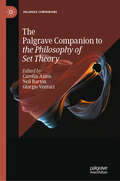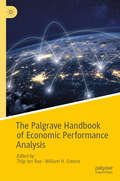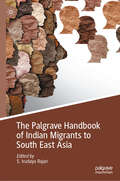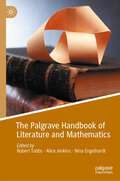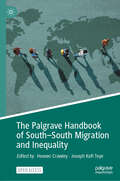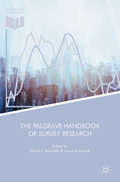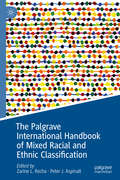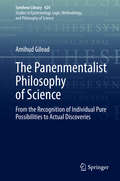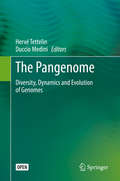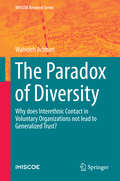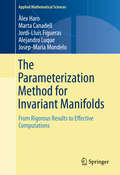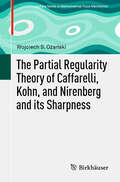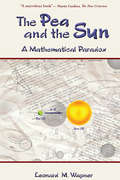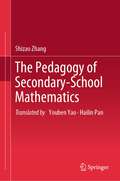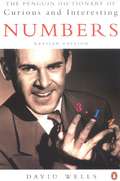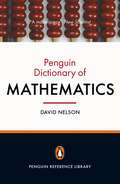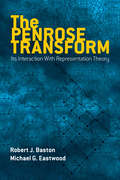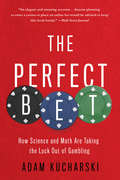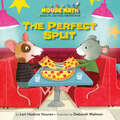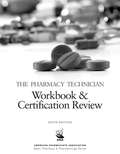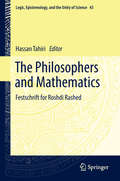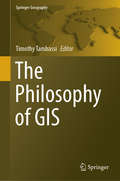- Table View
- List View
The Palgrave Companion to Oxford Economics
by Robert A. CordThe University of Oxford has been and continues to be one of the most important global centres for economics. With six chapters on themes in Oxford economics and 24 chapters on the lives and work of Oxford economists, this volume shows how economics became established at the University, how it produced some of the world’s best-known economists, including Francis Ysidro Edgeworth, Roy Harrod and David Hendry, and how it remains a global force for the very best in teaching and research in economics. With original contributions from a stellar cast, this volume provides economists – especially those interested in macroeconomics and the history of economic thought – with the first in-depth analysis of Oxford economics.
The Palgrave Companion to the Philosophy of Set Theory (Palgrave Companions)
by Giorgio Venturi Carolin Antos Neil BartonThis volume showcases some of the up-and-coming voices of an emerging field - the philosophy of set theory - which in recent years has gained prominence in the philosophy of mathematics. The chapters in this volume both present new topics and propose solutions to old problems. It contains a broad picture of the philosophy of set theory, examining questions from epistemology and ontology, whilst touching on the use of formal theories in the study of mathematical infinity. Key features of this volume: • Explores new and interesting connections between philosophy, set theory, and the study of infinity. • Considers questions intended to appeal to a wider audience in both philosophy and mathematical logic. • Examines three key areas of study: Epistemology, Formal Theories, and Ontology. The book provides a key reference text for future debates and is ideal for both newcomers to the philosophy of set theory and established researchers in the field.
The Palgrave Handbook of Economic Performance Analysis
by William H. Greene Thijs Ten RaaThis Handbook takes an econometric approach to the foundations of economic performance analysis. The focus is on the measurement of efficiency, productivity, growth and performance. These concepts are commonly measured residually and difficult to quantify in practice. In real-life applications, efficiency and productivity estimates are often quite sensitive to the models used in the performance assessment and the methodological approaches adopted by the analysis. The Palgrave Handbook of Performance Analysis discusses the two basic techniques of performance measurement – deterministic benchmarking and stochastic benchmarking – in detail, and addresses the statistical techniques that connect them. All chapters include applications and explore topics ranging from the output/input ratio to productivity indexes and national statistics.
The Palgrave Handbook of Indian Migrants to South East Asia
by S. Irudaya RajanThis Handbook is a charting exercise to determine contemporary patterns of Indian migration to Southeast Asia. It will determine two waves/sectors of the Indian migration process to Southeast Asia, high skilled migration and semi-skilled to low skilled migration. However, such a research project is not complete without understanding the context of social and political dilemmas of Indian communities in Southeast Asia as well as the interstitial spaces some Indian migrants or migrant communities might fall through as stateless Indians or Indian communities. The Handbook is premised largely on Indian-ASEAN, twenty-five years of partnering relations in diplomacy, politics, economy, people to people exchange, human capital development and exchange as well as coordinated infrastructural development. It reinforces the much-discussed &‘Look East&’ and current &‘Act East&’ initiatives of the Indian government, highlighting cooperation with the Southeast Asian and East Asian economies, as some political perspectives suggest, to counterbalance China&’s economic influence in the region.
The Palgrave Handbook of Literature and Mathematics
by Nina Engelhardt Alice Jenkins Robert TubbsThis handbook features essays written by both literary scholars and mathematicians that examine multiple facets of the connections between literature and mathematics. These connections range from mathematics and poetic meter to mathematics and modernism to mathematics as literature. Some chapters focus on a single author, such as mathematics and Ezra Pound, Gertrude Stein, or Charles Dickens, while others consider a mathematical topic common to two or more authors, such as squaring the circle, chaos theory, Newton’s calculus, or stochastic processes. With appeal for scholars and students in literature, mathematics, cultural history, and history of mathematics, this important volume aims to introduce the range, fertility, and complexity of the connections between mathematics, literature, and literary theory.
The Palgrave Handbook of South–South Migration and Inequality
by Heaven Crawley Joseph Kofi TeyeThis open access handbook examines the phenomenon of South-South migration and its relationship to inequality in the Global South, where at least a third of all international migration takes place. Drawing on contributions from nearly 70 leading migration scholars, mainly from the Global South, the handbook challenges dominant conceptualisations of migration, offering new perspectives and insights that can inform theoretical and policy understandings and unlock migration’s development potential. The handbook is divided into four parts, each highlighting often overlooked mobility patterns within and between regions of the Global South, as well as the inequalities faced by those who move. Key cross-cutting themes include gender, race, poverty and income inequality, migration decision making, intermediaries, remittances, technology, climate change, food security and migration governance. The handbook is an indispensable resource on South-South migration and inequality for academics, researchers, postgraduates and development practitioners.
The Palgrave Handbook of Survey Research
by Jon A. Krosnick David L. VannetteThis handbook is a comprehensive reference guide for researchers, funding agencies and organizations engaged in survey research. Drawing on research from a world-class team of experts, this collection addresses the challenges facing survey-based data collection today as well as the potential opportunities presented by new approaches to survey research, including in the development of policy. It examines innovations in survey methodology and how survey scholars and practitioners should think about survey data in the context of the explosion of new digital sources of data. The Handbook is divided into four key sections: the challenges faced in conventional survey research; opportunities to expand data collection; methods of linking survey data with external sources; and, improving research transparency and data dissemination, with a focus on data curation, evaluating the usability of survey project websites, and the credibility of survey-based social science. Chapter 23 of this book is open access under a CC BY 4. 0 license at link. springer. com.
The Palgrave International Handbook of Mixed Racial and Ethnic Classification
by Peter J. Aspinall Zarine L. RochaThis handbook provides a global study of the classification of mixed race and ethnicity at the state level, bringing together a diverse range of country case studies from around the world. The classification of race and ethnicity by the state is a common way to organize and make sense of populations in many countries, from the national census and birth and death records, to identity cards and household surveys. As populations have grown, diversified, and become increasingly transnational and mobile, single and mutually exclusive categories struggle to adequately capture the complexity of identities and heritages in multicultural societies. State motivations for classification vary widely, and have shifted over time, ranging from subjugation and exclusion to remediation and addressing inequalities. The chapters in this handbook illustrate how differing histories and contemporary realities have led states to count and classify mixedness in different ways, for different reasons. This collection will serve as a key reference point on the international classification of mixed race and ethnicity for students and scholars across sociology, ethnic and racial studies, and public policy, as well as policy makers and practitioners.
The Panenmentalist Philosophy of Science: From the Recognition of Individual Pure Possibilities to Actual Discoveries (Synthese Library #424)
by Amihud GileadThis book presents a philosophy of science, based on panenmentalism: an original modal metaphysics, which is realist about individual pure (non-actual) possibilities and rejects the notion of possible worlds. The book systematically constructs a new and novel way of understanding and explaining scientific progress, discoveries, and creativity. It demonstrates that a metaphysics of individual pure possibilities is indispensable for explaining and understanding mathematics and natural sciences. It examines the nature of individual pure possibilities, actualities, mind-dependent and mind-independent possibilities, as well as mathematical entities. It discusses in detail the singularity of each human being as a psychical possibility. It analyses striking scientific discoveries, and illustrates by means of examples of the usefulness and vitality of individual pure possibilities in the sciences.
The Pangenome: Diversity, Dynamics and Evolution of Genomes
by Hervé Tettelin Duccio MediniThis open access book offers the first comprehensive account of the pan-genome concept and its manifold implications. The realization that the genetic repertoire of a biological species always encompasses more than the genome of each individual is one of the earliest examples of big data in biology that opened biology to the unbounded. The study of genetic variation observed within a species challenges existing views and has profound consequences for our understanding of the fundamental mechanisms underpinning bacterial biology and evolution. The underlying rationale extends well beyond the initial prokaryotic focus to all kingdoms of life and evolves into similar concepts for metagenomes, phenomes and epigenomes. The book’s respective chapters address a range of topics, from the serendipitous emergence of the pan-genome concept and its impacts on the fields of microbiology, vaccinology and antimicrobial resistance, to the study of microbial communities, bioinformatic applications and mathematical models that tie in with complex systems and economic theory. Given its scope, the book will appeal to a broad readership interested in population dynamics, evolutionary biology and genomics.
The Paradox of Diversity
by Wahideh AchbariThis book is about ethnic diversity in voluntary organizations and seeks to explain whether intergroup contact contributes to the development of generalized trust. It relies on a novel multilevel design and data from Amsterdam in which 40 voluntary organizations and 463 participants have been sampled. Contrary to conventional wisdom, this book argues that cognitive processes are contributing more toward the evaluation of strangers or generalized trust than interethnic contact. Since trusting unknown people is essentially a risky endeavor, this suggests that participants of both association types who report trusting strangers can afford to do so, because they are better educated, have a more positive worldview, and have had fewer negative life experiences. That is to say, they are socially more successful and view their future as more promising. Previous findings are inconclusive since most studies that conclude diversity has led to less generalized trust do not include interethnic contact directly in their analyses. These studies also downplay the importance of cognitive processes, which may shape generalized trust. What is more, people join ethnically diverse civic groups, because they already have more trustful attitudes, rather than learning to trust through interethnic contact. Despite the recent multiculturalist backlash, this book demonstrates that participation in ethno-national organizations does not pose a threat to social cohesion. The analysis in this book serves to build a general theory of trust that moves beyond emphasizing interaction between people who are different from each other, but one that includes the importance of cognition.
The Parameterization Method for Invariant Manifolds
by Àlex Haro Marta Canadell Jordi-Lluis Figueras Alejandro Luque Josep Maria MondeloThismonograph presents some theoretical and computational aspects of theparameterization method for invariant manifolds, focusing on the followingcontexts: invariant manifolds associated with fixed points, invariant tori inquasi-periodically forced systems, invariant tori in Hamiltonian systems andnormally hyperbolic invariant manifolds. This book provides algorithms ofcomputation and some practical details of their implementation. The methodologyis illustrated with 12 detailed examples, many of them well known in theliterature of numerical computation in dynamical systems. A public version of the software used for some of the examples is available online. Thebook is aimed at mathematicians, scientists and engineers interested in thetheory and applications of computational dynamical systems.
The Partial Regularity Theory of Caffarelli, Kohn, and Nirenberg and its Sharpness (Advances in Mathematical Fluid Mechanics)
by Wojciech S. OżańskiThis monograph focuses on the partial regularity theorem, as developed by Caffarelli, Kohn, and Nirenberg (CKN), and offers a proof of the upper bound on the Hausdorff dimension of the singular set of weak solutions of the Navier-Stokes inequality, while also providing a clear and insightful presentation of Scheffer’s constructions showing their bound cannot be improved. A short, complete, and self-contained proof of CKN is presented in the second chapter, allowing the remainder of the book to be fully dedicated to a topic of central importance: the sharpness result of Scheffer. Chapters three and four contain a highly readable proof of this result, featuring new improvements as well. Researchers in mathematical fluid mechanics, as well as those working in partial differential equations more generally, will find this monograph invaluable.
The Passionate Triangle
by Rebecca ZorachTriangles abounded in the intellectual culture of early modern Europe—the Christian Trinity was often mapped as a triangle, for instance, and perspective, a characteristic artistic technique, is based on a triangular theory of vision. Renaissance artists, for their part, often used shapes and lines to arrange figures into a triangle on the surface of a painting—a practice modern scholars call triangular composition. But is there secret meaning in the triangular arrangements artists used, or just a pleasing symmetry? What do triangles really tell us about the European Renaissance and its most beguiling works of art? In this book, Rebecca Zorach takes us on a lively hunt for the triangle’s embedded significance. From the leisure pursuits of Egyptian priests to Jacopo Tintoretto’s love triangles, Zorach explores how the visual and mathematical properties of triangles allowed them to express new ideas and to inspire surprisingly intense passions. Examining prints and paintings as well as literary, scientific, and philosophical texts, The Passionate Triangle opens up an array of new ideas, presenting unexpected stories of the irrational, passionate, melancholic, and often erotic potential of mathematical thinking before the Scientific Revolution.
The Pea and the Sun: A Mathematical Paradox
by Leonard M. WapnerTake an apple and cut it into five pieces. Would you believe that these five pieces can be reassembled in such a fashion so as to create two apples equal in shape and size to the original? Would you believe that you could make something as large as the sun by breaking a pea into a finite number of pieces and putting it back together again? Neither did Leonard Wapner, author of The Pea and the Sun, when he was first introduced to the Banach-Tarski paradox, which asserts exactly such a notion. Written in an engaging style, The Pea and the Sun catalogues the people, events, and mathematics that contributed to the discovery of Banach and Tarski's magical paradox. Wapner makes one of the most interesting problems of advanced mathematics accessible to the non-mathematician.
The Pedagogy of Secondary-School Mathematics
by Shizao ZhangThis book elucidates the principal aspects and characteristics of secondary school mathematics teaching and learning in China. It combines the cultivation of students' mathematical abilities with the improvement of teaching skills, and explores from both theory and practice to create mathematical pedagogy which has been widely recognized by experts in this field. This book presents a number of mathematics teaching principles and methods, and has been used as an important resource book for mathematics teachers’ education.
The Penguin Book Quiz: From The Very Hungry Caterpillar to Ulysses – The Perfect Gift!
by James WaltonTHE PERFECT QUIZ BOOK FOR BOOKWORMS!Which Haruki Murakami novel shares its title with a Beatles song? In Roald Dahl's Charlie and the Chocolate Factory, what is Charlie's surname? What is heavy-drinking Rachel Watson known as in the title of a 21st-century bestseller? And what do you get if you add the number of Bennet sisters in Jane Austen's Pride and Prejudice to the number of Karamazov brothers in Fyodor Dostoevsky's The Brothers Karamazov?With four hundred questions covering books from literary classics to modern bestsellers, through iconic children's books and books you say that you've read but really you haven't, The Penguin Book Quiz is as appropriate for a making you look well-read at a party as it is for a book-loving family to tuck into after Christmas dinner: it's as enjoyable to read as it is to play.Featuring the work of everyone from Antony Beevor to Zadie Smith, books from The Very Hungry Caterpillar to Ulysses, and with movie, music, television and literary references abound, this entertaining quiz tickles the fancy (and the brains) of light and heavy readers alike.Answers:- Norwegian Wood- Bucket- The Girl on the Train- Eight (five sisters, three brothers)
The Penguin Dictionary of Curious and Interesting Numbers
by David WellsWhy was the number of Hardy's taxi significant? Why does Graham's number need its own notation? How many grains of sand would fill the universe? What is the connection between the Golden Ratio and sunflowers? Why is 999 more than a distress call? All these questions and a host more are answered in this fascinating book, which has now been newly revised, with nearly 200 extra entries and some 250 additions to the original entries. From minus one and its square root, via cyclic, weird, amicable, perfect, untouchable and lucky numbers, aliquot sequences, the Cattle problem, Pascal's triangle and the Syracuse algorithm, music, magic and maps, pancakes, polyhedra and palindromes, to numbers so large that they boggle the imagination, all you ever wanted to know about numbers is here. There is even a comprehensive index for those annoying occasions when you remember the name but can't recall the number.
The Penguin Dictionary of Mathematics: Fourth edition
by Dr David NelsonThe Penguin Dictionary of Mathematics takes in all branches of pure and applied mathematics, from algebra to mechanics and from number theory to statistics. Invaluable for students at all levels, it is also a useful and versatile source book for economists, business people, engineers, technicians and scientists of all kinds who use mathematics in the course of their work.
The Penrose Transform: Its Interaction with Representation Theory
by Michael G. Eastwood Robert J. Baston"Brings to the reader a huge amount of information, well organized and condensed into less than two hundred pages." -- Mathematical ReviewsIn recent decades twistor theory has become an important focus for students of mathematical physics. Central to twistor theory is the geometrical transform known as the Penrose transform, named for its groundbreaking developer. Geared toward students of physics and mathematics, this advanced text explores the Penrose transform and presupposes no background in twistor theory and a minimal familiarity with representation theory. An introductory chapter sketches the development of the Penrose transform, followed by reviews of Lie algebras and flag manifolds, representation theory and homogeneous vector bundles, and the Weyl group and the Bott-Borel-Weil theorem. Succeeding chapters explore the Penrose transform in terms of the Bernstein-Gelfand-Gelfand resolution, followed by worked examples, constructions of unitary representations, and module structures on cohomology. The treatment concludes with a review of constructions and suggests further avenues for research.
The Perfect Bet: How Science and Math Are Taking the Luck Out of Gambling
by Adam KucharskiThere is one thing about gambling that everyone knows: the house always wins. Lotteries are set up to guarantee profits, to the state. A craps game is a sure thing, but only if you own the table. Sometimes, however, everyone is wrong. After all, the reason that casinos ban card counters is that counting cards works. Indeed, for the past 500 years, gamblers-led by mathematicians and scientists-have been trying to figure out how to turn the tables on the house and pull the rug out from under Lady Luck. In The Perfect Bet, mathematician and award-winning writer Adam Kucharski tells the astonishing story of how the experts have done it, revolutionizing mathematics and science in the process. From Galileo to Alan Turing, betting has been scientists' playground for ideas: dice games in sixteenth-century bars gave birth to the theory of probability, and poker to game theory (mathematician John von Neumann wanted to improve his game) and to much of artificial intelligence. Kucharski gives us a collection of rogues, geniuses, and mavericks who are equally at home in a casino in Monte Carlo as investigating how to build an atomic bomb for the Manhattan Project. They include the mathematician who flipped a coin 25,000 times to see if it was fair; the college kids who gamed the Massachusetts lottery to yield millions of dollars in profit; and the horse-betting syndicates of Hong Kong's Happy Valley, who turned a wager on ponies into a multi-billion-dollar industry. With mathematical rigor and narrative flair, Adam Kucharski reveals the tangled history of betting and science. The house can seem unbeatable. In this book, Kucharski shows us just why it isn't. Even better, he shows us how the search for the perfect bet has been crucial for the scientific pursuit of a better world
The Perfect Split (Mouse Math)
by Lori Haskins HouranEach read-aloud book in the Mouse Math series focuses on a single, basic math concept and features adorable mice, Albert and Wanda, who live in a People House. Entertaining fiction stories capture kids&’ imaginations as the mice learn about numbers, shapes, sizes and more. Over 3 million copies sold worldwide!Melty's has games! Pizza! Prizes! Albert and Leo promise to split everything evenly, from the food to the tickets to the prizes. But some things just can't be split. When it comes to one special prize--winner takes all! Every Mouse Math title includes back matter activities that support and extend reading comprehension and math skills, plus free online activities. (Math concept: Equal to, less than, greater than).
The Pharmacy Technician Workbook and Certification Review (Basic Pharmacy and Pharmacology)
by American Pharmacy AssociationThis workbook was developed to correspond with the textbook, The Pharmacy Technician, Sixth Edition, by Perspective Press. For pharmacy technician students, it is a valuable tool for success. It provides a useful format for memorizing important information and checking knowledge. Hundreds of key concepts and terms are carefully explained, and there are over 1,000 exercises and problems for self testing. Answers are included at the back of the book "In the Workplace" sections provide sample job-related documents and skills checklists. The sixth edition includes additional skills checklists as well as "In the Workplace Activities" that provide practical, active-learning applications of the concepts discussed in The Pharmacy Technician. Working out these exercises and activities successfully will help you to succeed in your training.
The Philosophers and Mathematics: Festschrift for Roshdi Rashed (Logic, Epistemology, and the Unity of Science #43)
by Hassan TahiriThis book explores the unique relationship between two different approaches to understand the nature of knowledge, reality, and existence. It collects essays that examine the distinctive historical relationship between mathematics and philosophy. Readers learn what key philosophers throughout the ages thought about mathematics. This includes both thinkers who recognized the relevance of mathematics to their own work as well as those who chose to completely ignore its many achievements.The essays offer insight into the role that mathematics played in the formation of each included philosopher’s doctrine as well as the impact its remarkable expansion had on the philosophical systems each erected. Conversely, the authors also highlight the ways that philosophy contributed to the growth and transformation of mathematics. Throughout, significant historical examples help to illustrate these points in a vivid way. Mathematics has often been a favored interlocutor of philosophers and a major source of inspiration. This book is the outcome of an international conference held in honor of Roshdi Rashed, a renowned historian of mathematics. It provides researchers, students, and interested readers with remarkable insights into the history of an important relationship throughout the ages.
The Philosophy of GIS (Springer Geography)
by Timothy TambassiThis anthology aims to present the fundamental philosophical issues and tools required by the reflection within and upon geography and Geographic Information Systems (GIS) . It is an introduction to the philosophy for GIScience from an analytical perspective, which looks at GIS with a specific focus on its fundamental and most general concepts and distinctions. The first part of the book is devoted to explore some of the main philosophical questions arising from GIS and GIScience, which include, among others, investigations in ontology, epistemology, linguistics and geometrical modeling. The second part concerns issues related to spatial and cartographical representations of the geographical world. The third part is focused on the ontology of geography, specifically in terms of geographical entities, objects and boundaries. Finally, in the fourth part, the topic of GIS constitutes a starting point for exploring themes such as quantum geography and disorientation, and for defining professional profiles for geographers with competences in GIS environment. This book on a new and unexplored field of research could be a fundamental point of reference for professional philosophers and geographers interested in the theoretical reflection about the foundational concepts of GIScience. It is also interesting reading material for students (both undergraduates, postgraduates and Ph.D. students) in philosophy, geography, applied ontology, GIScience, geomatics and computer science.

